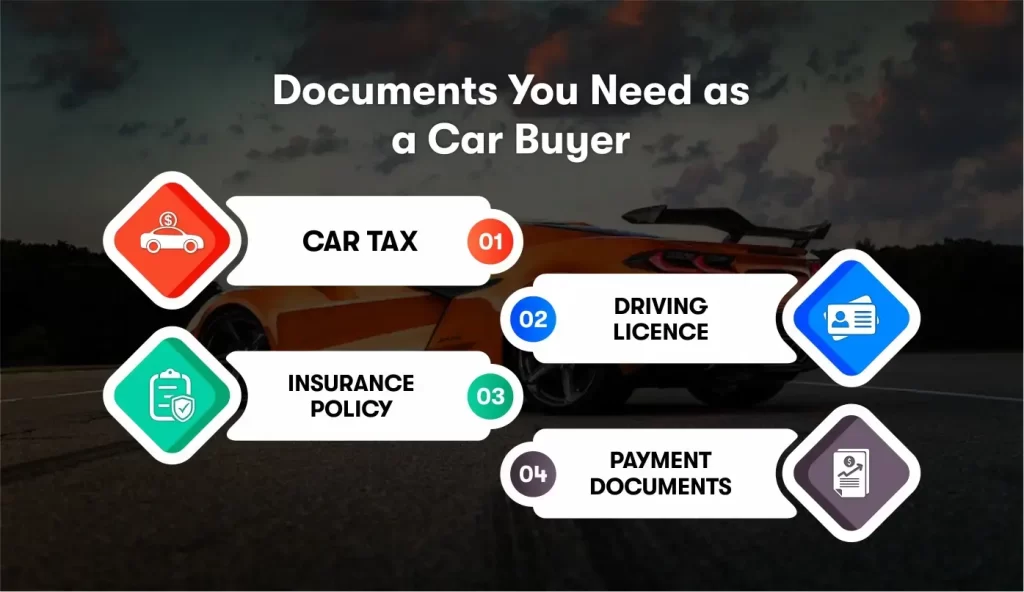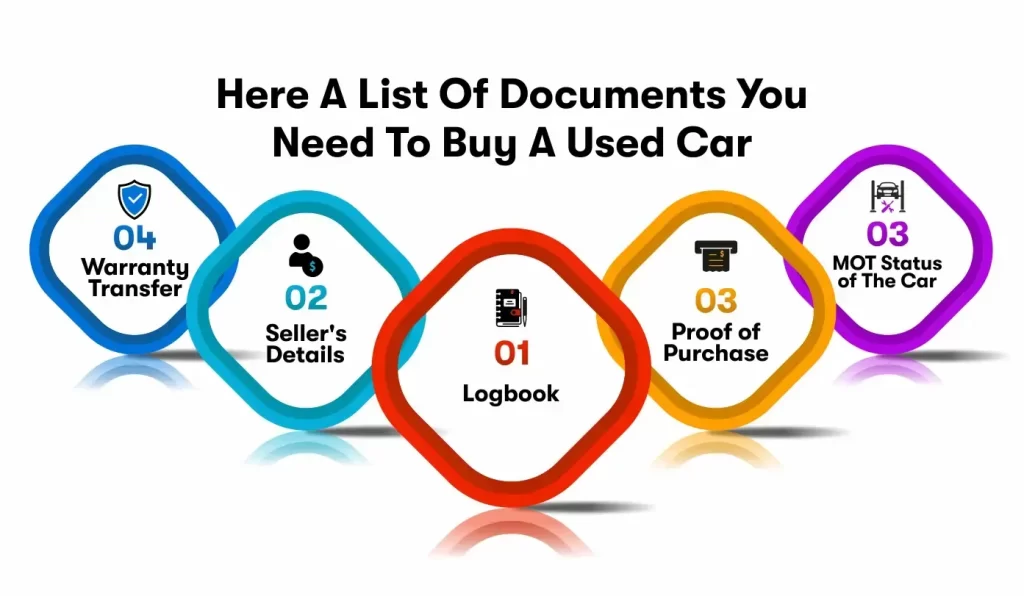A frequent question we get from our clients is, “What documents should I get when buying a used car?” Today, you will find a detailed answer to this question. Driving a car in the UK doesn’t require only driving skills. A few documents are also mandatory.
I’ll list all the documents you need to drive a car legally in the UK. Keep reading and mark your document checklist before buying a used car.
You need two major categories of documents when buying a used car.
Documents you require from the car seller
Documents you need as a car buyer
These categories further have a checklist of documents. Let’s check it out one by one.
Here is a checklist of the documents you must carry as a car buyer.
Below is a detailed explanation of each document.

After buying a used car, you must pay the vehicle tax yourself before driving it. Vehicle excise duty (VED) or car tax is a non-transferable tax between vehicle owners. You can pay the VED by post or by calling the DVLA.
If you buy a car through a private seller, the seller must inform the DVLA about the transfer of ownership of the vehicle. The seller must complete the new keeper section of the V5C document and submit it to the DVLA. Once this process is done, you can tax your car.
A driving license is an official document that proves your eligibility to drive a vehicle on public roads. It confirms your name, date of birth, and address to prove your identification. Before buying a car, you must have a valid driving licence, or else you can fall into legal trouble.
Before you buy a used car, you must have a valid insurance policy. It is illegal to drive a vehicle without an insurance policy in the UK. If you don’t have an insurance policy when you buy a car, it is recommended that you buy the car through a dealer rather than a private seller.
A dealer can offer you driveway insurance to help you out. Driveway insurance is a temporary insurance that allows you to arrange long-term insurance at your convenience. You must arrange comprehensive car insurance before the expiry of driveway insurance.
Note: All dealers do not provide driveway insurance. Confirm with your dealer before proceeding with the purchase.
Payment documents are vital for a car buyer. You must have the necessary paperwork with you when paying for the vehicle. Specifically, if you’ve taken a loan or utilised a car finance plan, you must have the evidence for that.
We need to check for various documents that you should ask from the seller. Here is a checklist of the documents.
Here is a great opportunity for you to save your time and get this documentation and process done by the Trade LMS. Now, let’s get into the details of all these documents, starting with the logbook.

The V5C document, also known as the logbook, proves that you’re the car’s registered keeper. The DVL watermark on this document proves its legitimacy. To confirm the watermark, you should ask the seller for the original V5C logbook rather than a copy.
If the V5C registration document is damaged or misplaced by the seller, you can apply for a replacement. You will get the replacement once you submit a V62 form to the DVLA. You can check the serial number written on the logbook to verify whether the vehicle has been stolen.
Checking the seller’s details allows you to question any information discrepancies. The information you provide about the seller must match those in the logbook. If you feel misinformed about anything, you must question the seller. Similarly, if the details in the logbook don’t match the car’s Vehicle Identification Number (VIN), you should ask the seller.
When buying a car, you must get proof of purchase. This receipt must mention the date of purchase, the buyer’s and seller’s addresses and names, the vehicle’s specifications, and confirmation of the purchase. The proof of purchase must be signed by both parties and kept safe to avoid any dispute.
You might buy a used car still under a manufacturer’s warranty. If this happens, you must ask the seller to transfer the warranty to you. A point to notice here is that not all warranties are transferable, but you must ask the seller for them. Warranty transfer applies to any maintenance agreement, existing service, or third-party warranty. Used car warranties vary; they are not the same for all used cars.
The MOT, or Ministry of Transport test, is an annual test for vehicles to check that they justify the safety and environmental standards for the UK’s roads. Before buying a car, you should ask the seller for a recent MOT certificate.
If the MOT certificate shows faults, you can discuss it with the seller to reach a mutual decision. If the seller doesn’t have an MOT certificate, you can verify the vehicle’s MOT online. For online verification, enter your registration number on the GOV.UK. You can then get the car’s valid MOT and expiry date.
A vehicle’s service history provides a record of work carried out on the car previously. A full-service history includes the names and addresses of the relevant garages, mileage at each service interval, details of each service, and any repairs or replacements done on the car.
Using a DVLA vehicle check, you can check the car’s legitimacy and condition. It is essential to confirm the car’s basic details, such as registration, tax status, and MOT expiry date. You can also verify the vehicle’s identity and information provided by the seller.
Sometimes, the DVLA check for cars misses a few points. Here, the private history checks come in handy. They provide a detailed insight into the vehicle’s background and cover aspects. These checks reveal whether the car has outstanding finance, has ever been in an accident, has been written off, or has been stolen.
These checks also verify mileage accuracy, previous owners, and whether the vehicle has been imported. Investing in a private history check helps avoid potential pitfalls and ensures a safer purchase.
A physical inspection and a vehicle test drive are vital elements for assessing the car’s condition. It tells you the car’s condition beyond the statements in the documents. During the inspection, you should check for:
Moreover, a test drive allows you to evaluate the vehicle’s performance, including the engine, brakes, suspension, and steering. To check the condition, pay attention to unusual noises or handling issues. This ensures the car meets your expectations and is safe to drive.
In conclusion, this blog has provided you with a complete checklist of the documents you need to buy a car. So, next time you want to buy a used car and wonder, “What documents should I get when buying a used car? ” Go through this blog. If you still have questions, reach out to the experts.
Trade LMS is your trusted partner when buying a used car. We are one of the best used car dealers in the UK with 6+ years of experience in the industry. Buying a used car from us guarantees a great vehicle that fits your budget and requirements. Make a deal with us to ensure a good purchase and satisfaction.
The trader’s details will not be printed on the V5. When you buy the car, the trader fills in your details and the green slip. You get only the green slip. The remainder of the V5 will be sent back to DVSA.
When buying a used car from a dealer, you can check the car’s history, condition, and documents. You can also take the car for a test drive.
After buying a used car in the UK, you should transfer ownership, collect documentation, arrange insurance, tax the vehicle, consider breakdown cover, and schedule a service.
Welcome to London Quality Used Cars! Trade LMS is a London-based automotive marketplace for the classified listing of used cars for buying and selling.
Monday – Friday: 08:00AM – 05:30 PM
Saturday: 08:00AM – 02:30PM
Sunday: Closed
© 2025 Trade London Motor Sports Ltd | All rights reserved.